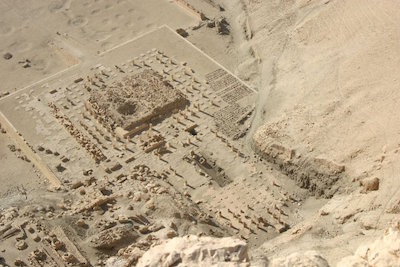
Montuhotep (Mentuhotep II, Montjuhotep II, Montjuhotpe II, Mentuhotpe II, Nebhepetre, Nebhetepre) was the fifth king of the Eleventh Dynasty. He is credited with fully re-unifying Egypt after the turmoil of the First intermediate Period. He also built a beautiful Mortuary Temple at Deir el Bahri which inspired the Mortuary Temple of Hatshepsut (New Kingdom). According to the Turin Kings list he reigned for an impressive fifty-one years.
Montuhotep is generally agreed to be the son of Intef III and his wife Iah. A relief at Wadi Shatt el-Rigal (near Gebel el-Silsila) includes a colossal figure of Montuhotep II dwarfing three other figures believed to be his mother, Intef III, and Khety his chancellor. There is also a masonry block found at Tod with reliefs portraying Montuhotep II towering over three kings, named Inhtef, lined up behind him. However, Montuhotep worked so diligently to enhance his reputation with his contemporaries with self-deification that some Egyptologists believe he may not have been a legitimate heir to the throne, though this might also be explained by his efforts to reunite Egypt.

At the outset of his rule, his territory stretched from the First Cataract (the first nome of Upper Egypt near Aswan) to Asyut (the thirteenth nome of Upper Egypt). Although he successfully reunited Upper and Lower Egypt, his reign was quiet and unassuming until around his fourteenth year. It is thought that this may have been due to his young age on ascending to the throne.
This was all to change in his fourteenth year, described in contemporary inscriptions as “the year of the crime of Thinis” (the nome which included the holy city of Abydos). It seems that Khety (a Heracleopolitan king of the Ninth and Tenth Dynasty) had regained control of Abydos (damaging part of the old necropolis in the process) and set his sights on the rest of Upper Egypt. Montuhotep responded by launching an offensive during which he took control of Abydos, Asyut, and Heracleopolis (the home of the Ninth and Tenth Dynasty kings).
It is not clear exactly when he succeeded in reuniting the country, but most scholars agree that reunification was probably complete by his thirtieth year on the throne (or at the very latest by his thirty-ninth year). Montuhotep did not stop there, however. He continued to expand his territory into Nubia, sending his Chancellor Khety to oversee the expansion. Some scholars suggest that there was an Egyptian inspired kingdom around Abu Simbel. This was decisively crushed by the expedition led by Khety, and so the wealth of Nubia was controlled by Montuhotep.

Montuhotep built (or restored) numerous temples and shrines throughout Egypt, even while he was fighting with the rulers of Heracleopolis. In fact, much of his building work was conducted in Upper Egypt in Abydos, Denderah, Elkab, and Elephantine. He was particularly fond of Montu (the warrior god of Thebes for whom he was named) and built temples in his honour at Medamud, Armant, and Tod.
His greatest monument was his Mortuary Temple (including his tomb) on the west bank near Thebes. Unlike his predecessors who built relatively simple tombs in Dra Abu el-Naga, he constructed a beautiful terraced structure against the cliffs of at Deir el-Bhari. He allowed a number of his senior officials to place their tombs close to his including Akhtoy (his chancellor), Dagi and Ipi (his viziers), and Henenu (his chief steward).
A mass grave was discovered in Deir el-Bahari containing the bodies of sixty Egyptian soldiers who are thought to have been casualties from the expedition to Nubia. It was a great honour to be buried so close to the king’s Mortuary Temple, so they must have been highly regarded by this martial ruler.
Pharaoh’s Names
Montuhotep’s throne name was Nebhetepre (or Nebhepetra “the Lord Ra is Pleased “). His Horus name changed during his rule. At the beginning of his rule he was named “He who gives heart to the Two Lands”, but later adopted “God of the White Crown” (representing Upper Egypt). Finally, he took the name “Uniter of the Two Lands”.
Horus Name
Sanhkibtawy (He who gives heart to the Two Lands)
Horus Name
Neterihedjet (God of the White Crown)
Horus Name
Sematawy (He who unites the Two Lands)
Nebty Name
Neterihedjet (God of the White Crown)
Nebty Name
Sematawy (He who unites the Two Lands)
Golden Horus
Bik Nebu Qah Shuti (Golden Horus lofty in plumes)
Prenomen
Nebhepetre (Lord Of The Rudder Is Re)

Nomen: Montuhotep (Montu is satisfied)
Nomen
Sahathor nubt iunt montuhotep (Son Of Hathor, The Lady Of Dendara, Montuhotep)
Bibliography
- Kathryn Bard (2008) An introduction to the Archaeology of Ancient Egypt
- Peter A Clayton (1994) Chronicle of the Pharaohs
- G Callender (2003) “The Middle Kingdom Renaissance” in Oxford History of Ancient Egypt. Edited by I Shaw
- E Hornung (1999) History of Ancient Egypt
- B.J. Kemp (1991) Ancient Egypt: anatomy of a civilization
- B. Manley (1996) The Penguin Historical Atlas of Ancient Egypt
- M Van de Mieroop (2010) A History of Ancient Egypt
Copyright J Hill 2015